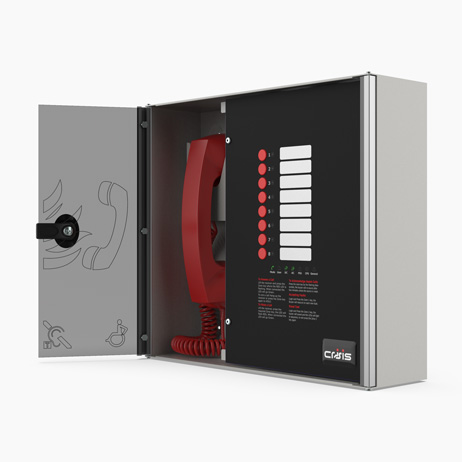Airports can be found all over the world. They vary from very small, single runway facilities to very large facilities that boast multiple runways, airport aprons, taxiway bridges, air traffic control centres, passenger facilities such as restaurants and lounges, and emergency services.
Millions of people pass through airports every single day and, as with most public places, peoples safety is the number one priority. This means that there must be stringent security measures, reliable fire detection and well planned evacuation procedures in place to ensure the safety of all passengers in an emergency situation. This includes making suitable provision for wheelchair users or people that are disabled.
Disabled Refuge
People that are disabled sometimes have difficulty evacuating to safety in an emergency event; especially if the only means of escape is via stairs. A disabled refuge provides people that are disabled or wheelchair users with somewhere relatively safe to wait while they call for help and await assistance. In the UK, disabled refuge systems are required in all non-domestic premises where an emergency exit is by stairs or where the building has more than one storey.
Disabled refuge points typically contain at least one outstation that provides hands-free communication with the building’s master station. This allows people who are disabled to easily communicate with building managers and emergency services so they can request assistance in the event of an emergency.
Handpicked Products for Airports
Crisis Emergency Voice Communication Systems (EVCs) are designed to provide two-way communication between those inside a building and the emergency services or building manager. Crisis EVC combines disabled refuge with other outstations, such as fire telephones and emergency assistance alarms, into one fully-integrated network to provide a reliable and cost-effective two-way communication system. The Crisis network can support up to 64 panels, each offering eight communication lines to provide a total of up to 512 lines. This makes Crisis EVC the ideal solution for airports of all sizes.
Typical Wiring Diagram

Crisis Disabled Refuge Control Panels

The Crisis EVC Master Station is ideal for small buildings which are required to have an EVC system, but which have a limited number of outstations. The Master Station can support up to eight lines of outstation, including type A fixed phones, hands-free type B disabled refuge points and emergency assist call points.

The Network EVC Master Station offers all the features of the Crisis EVC Master Station but also has in-built networking allowing it to form one of the 64 panels on a Crisis EVC network installation, accommodating a total of 512 outstations. Each panel can be set as a master station or network expander.

The Crisis EVC Expander Panel can support up to eight lines of outstation, including type A fixed phones, type B refuge hands free points and emergency assist call points. Expander panels are used to extend the Crisis network and have in-built networking which allows them to form one of the 64 panels on a Crisis EVC network installation.
Disabled Refuge Outstations

The Crisis Type B Outstation is designed to be used by the public as a disabled refuge call point. Type B outstations should be installed in disabled refuge locations to provide two-way communication between the master station and disabled refuge point.

The Crisis Type B Refuge Induction Loop Outstation combines all the features of the Crisis Type B Refuge Outstation but with the addition of an induction loop to aid those that use a hearing aid or loop listener.

Crisis Combined Type A & B Outstations can be used as a fire telephone or a disabled refuge call point. Crisis outstations are designed for use by multi-disability users, having high contrast signage in line with RNIB guidelines and an induction loop coil in the handset.

The Crisis Type B Weatherproof Outstation is designed for use in outdoor or exposed areas and is compatible with the Crisis standalone and network EVC systems. The outstation is supplied within a compact IP65 enclosure which is externally signed and is opened by operation of a lever lock, exposing the hands-free unit and operating instructions.
Why Choose Eurofyre?
- Complete System Supplier
- Eurofyre manufactures and supplies all aspects of fire detection and associated safety products and can provide expert advice and consultation.
- Demonstration and Training
- We offer demonstrations and expert training on a range of systems, including the Crisis range of EVC systems, in our very own sophisticated training facility.
- After-Sales Support
- Eurofyre offers both on-site and telephone support to assist you in ensuring that your system is fully functional and operating at maximum efficiency. Our after-sales care and support are second-to-none.
For more information about Crisis EVC, or to discuss any of the other products that Eurofyre have to offer, please feel free to get in touch either by phone on +44 (0) 1329 835 024, by email to [email protected] or via the online enquiry form situated on our contact page.
Don’t forget you can follow us on LinkedIn, Twitter and Facebook or sign up to our newsletter (in the footer below) to receive all the latest information from Eurofyre.